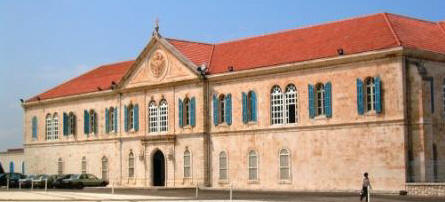
Maronite Wakfs of the Khazen family
Despite being very wealthy, The Khazen family never built a castle but instead built an impressive number of 27 covenants and schools, among which:
- St Antoine Church founded by Abou-Nader el-Khazen in 1600.
- Church dedicated to the Virgin Mary, offered by Abou-Nawfal in Ajaltoun 1647.
- St Antoine covenant of Capuchin Fathers given in 1671 by Santo Ben Fayad el-Khazen.
- Mar Elias el Hay Church and Covenant (Ghosta).
- Tamich Covenant donated by Abou-Nawfal in 1673.
- Wakf of Ain-Waraqa in 1690 donated by Chareh el-Khazen and his brother Fayad.
- Saint Roukoz covenant given to the Antonines in 1700 by Haykal, Dargham, Daham and Sakhr el-Khazen.
- Antoura College and covenant of Jesuit Fathers: 1/3 bought by Father Antonios and the other 2/3 offered by Abi-Charwan el Khazen.
- Saint Yachahe covenant, offered by Santa Nader el Khazen in 1729
- Mayrouba School, offered by Milane el-Khazen.
- St Doumit School in Zouk Mikael.
- St Elias Antelias covenant offered by Cheikh Khaled el-Khazen to the Antonine sisters.
- Ajaltoun School in 1751, donated by Cheikh Khaled.
- Old church of Faraya offered by Cheikh Chayban el-Khazen.
- Awkar covenant offered by Daham, Khattar and Joumblatt el-Khazen in 1832 to the Antonine sisters.
- Saydit el-Wata in 1783 was offered by both Cheikh Bechara and his cousin Santa.
- The field on which stands the statue of Notre-Dame of Lebanon at Harissa is a donation of Youssef Francis Abi-Nader el-Khazen.
- Old market in Zouk Mikael exploited today by the municipality.
Bkerke, the siege of the Maronite Patriarch, also belonged to the Khazens.
The story behind it is worth mentioning and goes as follows:
In 1704, the Maronite Patriarchate was located in North Lebanon, because it was there that the Maronites found refuge. The region was mostly non-Muslim and its leader Issa Hamade repeatedly asked Patriarch Douaihy a substantial sum of money. Facing the refusal of the latter, Hamade slapped and cursed him. Following this incident, the Patriarch wrote to Cheikh Hosn el-Khazen and the latter ensured the patriarcha’s travel from Deir-Qannoubine, his place of residence, to Kesrouan where he stayed for three months in the St Challita covenant of Ghosta. In 1750, the Khazens offered Bkerke to the Maronite Church and spent decades trying to convince them to move the patriarchate from the North in direction of Kesrouan where it’s safer. It wasn’t until a man from Kesrouan, Youssef Hobeiche, coming from a big family and a relative to the Khazens, became Patriarch in 1823 and had the winter seat transferred to Bkerke while keeping Dimane as a summer residence.
Of all the privileges inherited by the Khazen family, there is an additional one, hereditary: the one that permits two Cheikhs of the family, one from Ajaltoun and the second from Ghosta, to keep the conclave doors of the bishops united for the election of a new patriarchate.